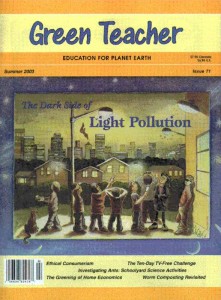Green Teacher 71, Summer 2003
 Features
Features
Casting Light on Light Pollution by Mike Hansen
More than just an energy-wasting nuisance, artificial night lighting is proving to have serious consequences for our health and environment. Mike Hansen provides educators with activities that raise awareness among students about the extent and effects of light pollution in their schools and communities.
Light Pollution: Causes and Cures by Cliff Haas
Light pollution is the only form of environmental pollution that can cost much less to cure than it costs society to perpetuate. Cliff Haas addresses the causes of light pollution, and offers simple ideas to reduce light pollution in your environment.
Recipes for Success: Integrating Environmental Education into Home Economics by Robin Ruff
Robin Ruff’s article demonstrates how environmental education can be easily integrated into common home economics topics such as food and textile studies, consumer education, and family studies.
Confronting Violence in Entertainment: The Youth Vote and TV-Free Challenge by Jacques Brodeur
Schools can help young people resist the influence of violence in entertainment, and to wean themselves from the tube. This article provides two powerful activities that can be used in all grade levels to help students think more critically about the role of television and violence in their lives.
Worm Composting Revisited by Jennifer Kusmanoff
If the term “worm bin” makes you think of bad smells and pesky fruit flies, think again. New vermiculture systems and strategies make it easy to succeed with classroom worm composting.
Inquiry Learning: Teaching for Conceptual Change in EE by Fletcher Brown
Revisiting the term inquiry, the author describes the “learning cycle,” a teaching model that examines current thinking on what inquiry learning is, and how best to put into practice in the classroom.
Investigating Ants: Projects for Curious Minds by Harriett Stubbs, Rita Hagevik and Edward Hessler
Familiar to most students, ants are so numerous as to represent 10-15% of total animal biomass on the planet – more than the weight of all humans combined. This article provides teachers of all grade levels with a plethora of inquiry-oriented teaching ideas and activities related to ants.
Inside the Internet: Ethical Consumerism by Katharine Isbell
And as always, over 20 new educational resources are profiled and evaluated in this issue of Green Teacher.
Leave a Reply
You must be logged in to post a comment.





